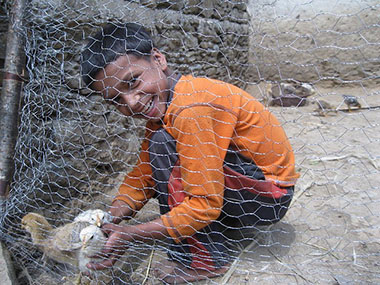For decades, the agricultural sector has been tasked with helping to curb undernutrition and reduce poverty levels, especially in rural areas in many developing countries. The livestock sector holds particular promise for supporting such development outcomes, since the consumption of animal-source foods is seen as both a key driver of child growth and raised household incomes.
But raising livestock in close proximity to the home also carries significant health risks, particularly for young children who are observed eating dirt and other substances- including animal fecal matter- off the ground while left unsupervised. In a recent study, IFPRI researchers Derek Headey and Kalle Hirvonen sought to account for the impact of heightened exposure to poultry feces on child stunting among households in Ethiopia. Their question: Do the benefits of raising poultry in such environments outweigh the risks?
More than half of rural households in Ethiopia own poultry. Of these, the vast majority are free range in the broadest sense of the term, as chickens (the main type of poultry being raised) scavenge for household food scraps both inside and outside of the family’s primary dwelling. Headey and Hirvonen undertook a survey on behalf of USAID’s Feed the Future program to determine the impact of poultry raising practices on child health and nutrition. They found that approximately half of households surveyed own poultry and half of those keep their poultry inside the dwelling overnight. The working hypothesis was that keeping their chickens indoors at night further heightened children’s risk of exposure to fecal matter.
Previous studies established a strong connection between heightened exposure to animal fecal matter and chronic infections linked to child stunting. Microbial tests reveal that chicken feces contain extremely high concentrations of many harmful bacteria such as E. coli, which can result in environmental enteric disorder (EED), or long-term damage to the gut. This condition is known to decrease the absorption of nutrients; more recently, it also has been shown to stimulate the immune system (due to more microbes passing through holes in the gut), which diverts needed nutrients from being utilized by other parts of the body. For a child whose body and brain need the right nutrients at the right time in order to achieve optimal growth and development, the effects of EED can be especially damaging.
So what did the researchers find out? Comparing households that reported keeping chickens indoors at night versus those reporting they kept them outdoors, Headey and Hirvonen found stunting rates in children to be 50 percent and 44 percent, respectively. This means that children living in households where chickens are kept indoors at night (increased exposure to chicken feces) were at higher risk of stunting than those living in households where chickens are kept outside at night. The researchers also found that, although poultry ownership was associated with lower stunting rates, keeping poultry inside the house was associated with higher stunting rates, thereby implying that increased exposure to feces might fully negate any nutritional benefits from owning poultry.
Free range chicken, it turns out, is only good for you when it’s raised outside of the home.







